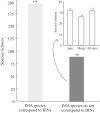Fast Census of Moth Diversity in the Neotropics: A Comparison of Field-Assigned Morphospecies and DNA Barcoding in Tiger Moths
- PMID: 26859488
- PMCID: PMC4747490
- DOI: 10.1371/journal.pone.0148423
Fast Census of Moth Diversity in the Neotropics: A Comparison of Field-Assigned Morphospecies and DNA Barcoding in Tiger Moths
Abstract
The morphological species delimitations (i.e. morphospecies) have long been the best way to avoid the taxonomic impediment and compare insect taxa biodiversity in highly diverse tropical and subtropical regions. The development of DNA barcoding, however, has shown great potential to replace (or at least complement) the morphospecies approach, with the advantage of relying on automated methods implemented in computer programs or even online rather than in often subjective morphological features. We sampled moths extensively for two years using light traps in a patch of the highly endangered Atlantic Forest of Brazil to produce a nearly complete census of arctiines (Noctuoidea: Erebidae), whose species richness was compared using different morphological and molecular approaches (DNA barcoding). A total of 1,075 barcode sequences of 286 morphospecies were analyzed. Based on the clustering method Barcode Index Number (BIN) we found a taxonomic bias of approximately 30% in our initial morphological assessment. However, a morphological reassessment revealed that the correspondence between morphospecies and molecular operational taxonomic units (MOTUs) can be up to 94% if differences in genitalia morphology are evaluated in individuals of different MOTUs originated from the same morphospecies (putative cases of cryptic species), and by recording if individuals of different genders in different morphospecies merge together in the same MOTU (putative cases of sexual dimorphism). The results of two other clustering methods (i.e. Automatic Barcode Gap Discovery and 2% threshold) were very similar to those of the BIN approach. Using empirical data we have shown that DNA barcoding performed substantially better than the morphospecies approach, based on superficial morphology, to delimit species of a highly diverse moth taxon, and thus should be used in species inventories.
Conflict of interest statement
Figures





Similar articles
-
Singleton molecular species delimitation based on COI-5P barcode sequences revealed high cryptic/undescribed diversity for Chinese katydids (Orthoptera: Tettigoniidae).BMC Evol Biol. 2019 Mar 14;19(1):79. doi: 10.1186/s12862-019-1404-5. BMC Evol Biol. 2019. PMID: 30871464 Free PMC article.
-
A two-step DNA barcoding approach for delimiting moth species: moths of Dongling Mountain (Beijing, China) as a case study.Sci Rep. 2018 Sep 24;8(1):14256. doi: 10.1038/s41598-018-32123-9. Sci Rep. 2018. PMID: 30250036 Free PMC article.
-
DNA barcoding reveals a largely unknown fauna of Gracillariidae leaf-mining moths in the Neotropics.Mol Ecol Resour. 2014 Mar;14(2):286-96. doi: 10.1111/1755-0998.12178. Epub 2013 Oct 29. Mol Ecol Resour. 2014. PMID: 24119085
-
Advancing taxonomy and bioinventories with DNA barcodes.Philos Trans R Soc Lond B Biol Sci. 2016 Sep 5;371(1702):20150339. doi: 10.1098/rstb.2015.0339. Philos Trans R Soc Lond B Biol Sci. 2016. PMID: 27481791 Free PMC article. Review.
-
Molecular-based rapid inventories of sympatric diversity: a comparison of DNA barcode clustering methods applied to geography-based vs clade-based sampling of amphibians.J Biosci. 2012 Nov;37(5):887-96. doi: 10.1007/s12038-012-9255-x. J Biosci. 2012. PMID: 23107924 Review.
Cited by
-
Assembling a DNA barcode reference library for the spiders (Arachnida: Araneae) of Pakistan.PLoS One. 2019 May 22;14(5):e0217086. doi: 10.1371/journal.pone.0217086. eCollection 2019. PLoS One. 2019. PMID: 31116764 Free PMC article.
-
A database and checklist of geometrid moths (Lepidoptera) from Colombia.Biodivers Data J. 2021 Sep 3;9:e68693. doi: 10.3897/BDJ.9.e68693. eCollection 2021. Biodivers Data J. 2021. PMID: 34566452 Free PMC article.
-
Maximizing Identification Precision of Hymenoptera and Brachycera (Diptera) With a Non-Destructive DNA Metabarcoding Approach.Ecol Evol. 2025 Jan 23;15(1):e70770. doi: 10.1002/ece3.70770. eCollection 2025 Jan. Ecol Evol. 2025. PMID: 39850753 Free PMC article.
-
Barcoding the butterflies of southern South America: Species delimitation efficacy, cryptic diversity and geographic patterns of divergence.PLoS One. 2017 Oct 19;12(10):e0186845. doi: 10.1371/journal.pone.0186845. eCollection 2017. PLoS One. 2017. PMID: 29049373 Free PMC article.
-
Tiger-Moths in Savannas in Eastern Amazon: First Assessment of Diversity and Seasonal Aspects.Neotrop Entomol. 2018 Dec;47(6):842-851. doi: 10.1007/s13744-017-0579-y. Epub 2018 Jan 6. Neotrop Entomol. 2018. PMID: 29307104
References
-
- Erwin TL (1982) Tropical forests: Their richness in Coleoptera and other arthropod species. Coleopt Bull 36: 74–75.
-
- Brehm G, Pitkin LM, Hilt N, Fiedler K (2005) Montane Andean rain forests are a global diversity hotspot of geometrid moths. J Biogeogr 32, 1621–1627.
-
- Lawton JH, Bignell DE, Bolton B, Bloemers GF, Eggleton P, Hammond PM et al. (1998) Biodiversity inventories, indicator taxa and effects of habitat modification in tropical forest. Nature 391: 72–76.
-
- Krell F (2004) Parataxonomy vs. taxonomy in biodiversity studies—pitfalls and applicability of ‘morphospecies’ sorting. Biodivers Conserv 13: 795–812.
Publication types
MeSH terms
LinkOut - more resources
Full Text Sources
Other Literature Sources
Miscellaneous

